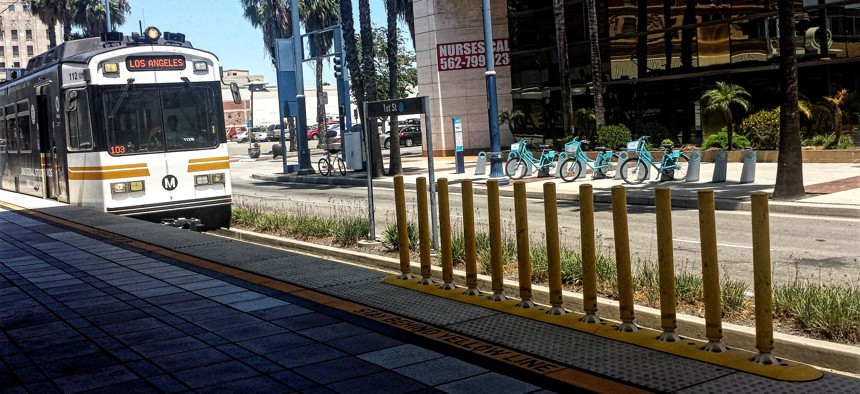The Future of Growing Cities Rests in Smart Transit

A Metro Blue Line train approaches the First Street Station in downtown Long Beach. Michael Grass / Route Fifty

Connecting state and local government leaders
In a guest article, Long Beach Mayor Robert Garcia looks at how the strength a local transportation system is reflected in the health and mobility of residents as well as in the resilience of the city.
As pressure mounts on municipal governments and transit agencies to persuade residents to trade their cars for alternative modes of transportation, smart transit offers the best solution to the growing pains in metropolitan areas. As Mayor of Long Beach, the second largest city in Los Angeles County, I have encouraged the use of green technology to not only accommodate our growing population but to plan and design a city of the future, built for multi-modal transportation.
If you look around Long Beach’s historic downtown core, you’ll see plenty of hard hats and cranes, with seven residential and retail projects completed recently and a dozen more on the way. Our planning commission is not only tasked with providing more housing options for residents but also developing transit-oriented projects. We have made it easier to utilize alternative means of transportation by planning developments close to transit, within walking distance of shops and cafes, and near bike storage.

Technology has changed the way people live their lives and engage with the surrounding community—everything from picking a place to eat to navigating daily commutes. That’s why our city has leveraged new, innovative technologies to transform the transit experience for our residents.
Along our local Long Beach Transit routes, we have implemented TranSmart signs with solar-powered technology that display the current time, route number, destination and arrival time of buses. Our city will also be replacing our entire fleet of LBT buses with 100 percent zero emission buses by 2020—a huge step toward a healthier, cleaner city for our residents and visitors.
In addition to the LBT system, our city is also home to the Los Angeles County Metropolitan Transportation Authority (Metro) Blue Line, the second busiest light rail system in the nation, with 10.2 million trips in 2016. It is also Metro’s oldest line. As a member of the Metro Board of Directors, I voted to replace all aging Blue Line trains with new trains and to re-signal traffic lights to cut down on trip times and congestion. We are also studying the feasibility of an express line and connecting the Blue Line to a new planned rail system in other densely populated areas. And to bridge the gap between spaces with limited transit stops, we have launched a bike share program, putting our 120 miles of bike lanes to good use. I am thrilled to report that since the launch of the program last year, we have seen 26,000 trips.

With these improvements, Long Beach is now ranked in the top 10 cities nationally for walkability and bike-ability. And we have even used technology to make it easier for those who elect to drive, with apps like EZParkLB, which shows parking availability and pricing in real time. In addition, we have partnered with Mercedes Benz to launch an electric vehicle charger giveaway program to encourage more people to adopt sustainable technology.
Yet transportation isn’t just about moving people around; it’s also about moving goods. As home of the nation’s largest port complex, Long Beach has made significant strides to transport goods in more efficient and environmentally sustainable ways, and we are quickly becoming a model for ports across the globe.
Through the Green Port Policy, the Port of Long Beach has successfully introduced smart technologies over the past twenty years, bringing us closer to our goal of becoming a zero-emissions facility. We have reduced greenhouse gases significantly by using electric equipment on the docks and are currently in the process of converting existing vehicles to clean cargo-handling technologies. Other advances include providing shore power for ships, allowing engines to be shut down, and on-dock rail that shifts more than 30 percent of the cargo shipments from trucks to trains. And our newest terminal, Middle Harbor, uses the most advanced automated technology available to move containers from ships and into economic markets throughout the country.
By combining investments in transit and technology, we have dramatically improved our residents’ quality of life while reducing impacts on the environment, but there is always more to be done. That’s why our city has sought partnerships with Los Angeles County and other governmental agencies to develop and expand smart transit. Cities that will perform best in the 21st Century are those that are willing to make leaps in innovation and collaboration. It is up to city leaders and other decision-makers to work together to advance smart transit by marrying data with emerging technologies, which is the next step for Long Beach.
Robert Garcia is the Mayor of Long Beach, California, and a member of the Los Angeles County Metropolitan Transportation Authority.

NEXT STORY: Why Mayors Are Flocking to SXSW




